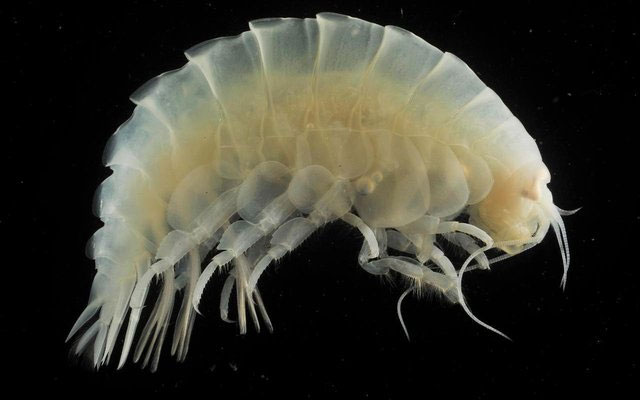Creatures that can survive in a place with pressure equivalent to 48 jet planes
That's the Mariana Trench. It's the deepest point on Earth. Even if you dropped Mount Everest into the Mariana Trench, it would still be more than a kilometer below the surface.
The deepest ocean trench is also where light cannot reach the bottom. In particular, the pressure in this area is equivalent to the weight of 48 jet planes. However, according to scientists, somehow life can still survive and develop in this harsh environment.
Accordingly, there are very strange creatures that mysteriously survive in the Mariana Trench. According to Mr. Douglas Bartlett, the scientist who led the expedition to the Challenger Deep in 2012: " If you just take a quick look, you won't be very impressed, because the sediment is mostly gray-green. However, if there is a little food, some of the strangest creatures on the planet will appear from the darkness."
Mysterious creatures under the Mariana Trench
First , amphipods (or Arthropods) are crustaceans. In fact, some of them can grow up to 30 centimeters long. Like lobsters, these creatures have hard exoskeletons made of calcium carbonate. This is something we don't usually find at depths of more than 10,000 meters.

An amphipod living in the Mariana Trench. (Photo: Newcastle University)
The reason is that when exceeding a depth of 4,500 m, the enormous pressure and low temperature of the water will dissolve calcium carbonate. So, what is the secret of amphipods?
According to experts, amphipods have a secret weapon that is like a shield. They are covered in a synthetic aluminum armor inside their bodies using aluminum found on the sea floor. This shell is their best protection against predators lurking in the abyss.
Second, the creature that surprised many scientists when it was able to live in the Mariana Trench is the Mariana snailfish (Pseudoliparis swirei). This is the deepest fish ever discovered. Specifically, they were found at a depth of more than 8,000m. In fact, there are many strange things about these snailfish.

Mariana snailfish are a species of fish that can withstand great pressure. (Photo: Phys).
Scientists point out that Mariana snailfish have a flexible skeleton, which helps them withstand great pressure.
However, the Mariana snailfish is blind. This is not too surprising because this fish lives in a dark environment without sunlight.
Scientist Douglas Bartlett added that the skin of this fish is semi-transparent. Therefore, we can see its internal organs. In addition, Mariana snailfish is one of the top "predators" in their habitat.
Third , xenophyophores are one of the special creatures in the Mariana Trench. They are single-celled organisms, similar to giant amoebas. At about 10 centimeters long, xenophyophores are among the largest single-celled organisms on Earth.

Xenophyophores are one of the organisms that can survive in the Mariana Trench. (Photo: Businessinsider).
Fourth , the deepest trench of the ocean also has another strange creature called the sea cucumber . They are small and transparent sea cucumbers. These creatures usually crawl along the ocean floor using tentacle-like legs.

Tiny sea cucumbers found in the deepest trench of the ocean. (Photo: Oceaninfo).
Fifth , plastic . This is probably the most surprising thing humans have found in the Mariana Trench. In 1998, a remotely operated submersible discovered a plastic bag at a depth of 10,898 m. Then, in 2019, an explorer also found some pieces of plastic there.

Plastic found in the Mariana Trench. Photo: Sustainability Times
Furthermore, researchers found numerous microplastic particles inside the stomachs of amphipods in the Challenger Deep abyss in the Mariana Trench. The researchers called this the deepest microplastic ingestion on record.
Plastics and microplastics found in the Mariana Trench show that even in the most remote places on the planet, negative human impacts are still present.
How was the Mariana Trench formed?

The Mariana Trench was formed by the collision of two tectonic plates. (Photo: Shutterstock).
The Mariana Trench is nearly 2,550 km long, but its average width is only about 69 km. According to scientists, the Mariana Trench was formed by the collision of two tectonic plates, which are large floating pieces of the Earth's crust. The collision caused the older and larger Pacific tectonic plate to lie below the Mariana tectonic plate, thereby forming a crescent-shaped trench on the seabed.
The deepest part of the Mariana Trench is called the Challenger Deep and was first surveyed by a Royal Navy ship in 1951 using sonar. The depth was then measured to be about 10,900 m.
However, in 1962, a US Navy ship measured the depth of the Challenger Deep at 10,915m.
- What has helped fishes withstand tremendous water pressure up to thousands of tons in the deep sea?
- Strange creatures do not have both anus and anus, but survive for over 500 million years
- Sleep on a plane that looks ... deaf
- Earth creatures born in 'alien-like' horror place
- Detecting concussions about 20 species of strange creatures in Antarctica
- How to live in the coldest place on Earth
- Strange 'resistance' of earth bacteria
- Unprotected creatures still survive in the universe
- How the plane took off on the solar system planets
- Video: The scene of two people flying next to Airbus A380 is unbelievably impressive
- Planes around the world
- The benefits are endless from whale carcasses
 Surprised: Fish that live in the dark ocean still see colors
Surprised: Fish that live in the dark ocean still see colors Japan suddenly caught the creature that caused the earthquake in the legend
Japan suddenly caught the creature that caused the earthquake in the legend A series of gray whale carcasses washed ashore on California's coast
A series of gray whale carcasses washed ashore on California's coast Compare the size of shark species in the world
Compare the size of shark species in the world